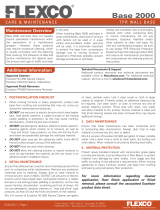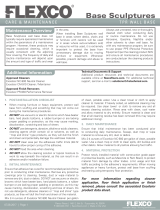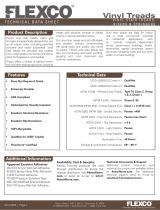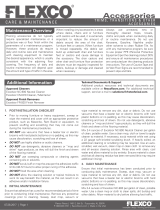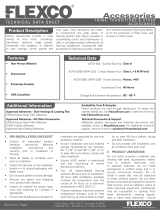Page is loading ...

Flexco Floors | 1401 E. 6th St. - Tuscumbia, AL 35674
P: 800.633.3151 | flexcofloors.com | Made in the USA
12.29.2017 | Page 1
TECHNICAL DATA SHEET
TP WALL BASE
Base 2000
™
Flexco Base 2000
™
Wall Base is a
unique thermoplastic rubber (TP) wall
base product that is as attractive as it
is affordable. Base 2000
™
wall base is
incredibly durable, allowing it to stand up
to a wide range of use when compared
to vinyl wall base.
Base 2000
™
wall base is designed for
use in both commercial and residential
wall base applications. Base 2000
™
wall
base is available in various heights, from
2 1/2" to 6", and in cove or no toe to
match a variety of flooring installations
and application requirements.
Base 2000
™
wall base is FloorScore
certified, can contribute to LEED credits
and meets a variety of VOC requirements.
Base 2000
™
wall base is manufactured in
the USA.
• Extremely Durable
• Extremely Flexible
• Will Not Shrink, Gap or Cup
• 100% Recycleable
• Qualifies for LEED® Credits
• FloorScore® Certified
Features
Toe Styles:
Nominal Base Height:
Nominal Base Length:
Nominal Base Thickness:
LEED v2009 IEQ Credit 4.1:
ASTM F1861 – Resilient Wall Base:
ASTM E648 (NFPA 253) - Critical Radiant Flux:
ASTM E662 (NFPA 258) - Smoke Density:
ASTM E84 - Flammability:
CAN/ULC-S102.2 - Surface Burning:
Acclimation Time:
Storage & Acclimation Temperature:
Cove, No Toe
2 1/2" (63.5 mm)
4" (101.6 mm)
4 1/2" (114.3 mm)
6" (152.1 mm)
48" Sections (1.22 m)
120' Rolls (36.58 m)
1/8" (3.2 mm)
Qualifies
Type TP, Group 2, Style A & B
Class I, > 0.45 W/cm2
Passes, <450
Class A
FSR 10, SDS 60
48 Hours
65° - 85° F
Product Description
Technical Data
Approved Adhesives
AW-510 Acrylic Wet-Set Adhesive
WB-600 Acrylic Wall Base Adhesive
C-630 Contact Adhesive
Additional Accessories
Inside and outside factory corners,
rubber corner blocks and mini-rubber
corners are available to match wall base
installations.
Availability, Cost & Samples
Flexco products are sold through
distribution. To locate the nearest
distributor, visit flexcofloors.com or send
an e-mail to info@flexcofloors.com.
Technical Documents & Support
Additional product resources and
technical documents are available online
at flexcofloors.com. For additional
technical support, send an e-mail to
solutions@rhctechnical.com.
Additional Information

12.29.2017 | Page 2
Flexco Floors | 1401 E. 6th St. - Tuscumbia, AL 35674
P: 800.633.3151 | flexcofloors.com | Made in the USA
TECHNICAL DATA SHEET
TP WALL BASE
Base 2000
™
TPR Wall Base, Rubber Corner Blocks & Corners
Base Height:
Base Thickness:
Base Length:
Carton Quantity:
Carton Weight - 2 1/2":
Carton Weight - 4":
Carton Weight - 4 1/2":
Carton Weight - 6":
2 1/2" (63.5 mm), 4" (101.6 mm),
4 1/2" (114.3 mm), 6" (152.1 mm)
1/8" (3.2 mm)
48" (1.22 m) Sections
120' (36.58 m) Coils
30 Pieces / 1 Coil
27 lbs.
39 lbs.
45 lbs.
60 lbs.
Cove Base No Toe Base
Base Height:
Base Thickness:
Base Length:
Carton Quantity:
Carton Weight - 2 1/2":
Carton Weight - 4":
Carton Weight - 6":
2 1/2" (63.5 mm), 4" (101.6 mm),
4 1/2" (114.3 mm), 6" (152.1 mm)
1/8" (3.2 mm)
48" (1.22 m) Sections
120' (36.58 m) Coils
30 Pieces / 1 Coil
26 lbs.
38 lbs.
60 lbs.
Rubber Corner Blocks
Mini-Rubber Corner Blocks
1. PRE-INSTALLATION CHECKLIST
• Consult all associated product
literature concerning installation and
warranty prior to installation.
• Allow all trades to complete work
prior to installation.
• Deliver all materials to the installation
location in its original packaging with
labels intact.
• Inspect all materials to ensure there
is no damage.
• Do not stack pallets to avoid damage.
• Ensure installation area and material
storage temperatures are between
65º F (19º C) and 85º F (30º C) and
40% - 65% RH for at least 48 hours
before, during and after installation.
• Ensure HVAC system is operational
and fully functioning at normal
operating conditions 48 hours prior to,
during and 48 hours after installation.
• Protect installation area from extreme
temperature changes, such as heat
and freezing, as well as direct sunlight
for at least 48 hours before, during
and after installation.
• Do not proceed with installation until
all conditions have been met.
2. PRODUCT LIMITATIONS
Do not install materials over existing wall
base, flash-coved rubber, vinyl or linoleum
flooring, cork, or asphaltic materials. Do
Corner Type:
Corner Height:
Corner Thickness:
Corner Return Length:
Carton Quantity:
Carton Weight:
Inside & Outside
2 3/4" (69.85 mm),
4 1/4" (107.96 mm),
4 3/4" (120.65 mm),
6 1/4" (158.75 mm),
8" (203.2 mm)
1/2" (12.77 mm)
1"
15 Pieces
1.65 lbs. (2 3/4"), 2.1 lbs. (4 1/4"),
2.35 lbs. (4 3/4"), 3 lbs. (6 1/4"),
3.84 lbs. (8")
Corner Type:
Corner Height:
Corner Thickness:
Corner Return Length:
Corner Carton Quantity:
Inside Carton Weight:
Outside Carton Weight:
Inside & Outside
2 3/4" (69.85 mm),
4 1/4" (107.96 mm),
6 1/4" (158.75 mm)
0.060" - 0.080 " (1.5 - 2 mm)
1"
15 Pieces
0.67 lbs. (2 3/4"), 1.04 lbs. (4 1/4"),
1.53 lbs. (6 1/4")
0.77 lbs. (2 3/4"), 1.18 lbs. (4 1/4"),
1.74 lbs. (6 1/4")
Corner Type:
Corner Height:
Corner Thickness:
Corner Return Length:
Corner Carton Quantity:
Carton Weight - 2 1/2":
Carton Weight - 4":
Carton Weight - 6":
Inside & Outside
2 1/2" (63.5 mm), 4" (101.6 mm),
6" (152.1 mm)
1/8" (3.2 mm)
3"
30 Pieces
2 lbs.
3.8 lbs.
5 lbs.
Cove Base Factory Corners
Corner Type:
Corner Height:
Corner Thickness:
Corner Return Length:
Corner Carton Quantity:
Carton Weight - 2 1/2":
Carton Weight - 4":
Inside & Outside
2 1/2" (63.5 mm), 4" (101.6 mm)
1/8" (3.2 mm)
3"
30 Pieces
2 lbs.
3.8 lbs.
No Toe Base Factory Corners

12.29.2017 | Page 3
Flexco Floors | 1401 E. 6th St. - Tuscumbia, AL 35674
P: 800.633.3151 | flexcofloors.com | Made in the USA
TECHNICAL DATA SHEET
TP WALL BASE
Base 2000
™
recommendations. Install wall base
within 12 hours after sanding/grinding to
prevent re-oxidation. Metal substrates
are non-porous – follow all installation
instructions, trowel sizes and flash times
for non-porous substrates.
4. FACTORY CORNER INSTALLATION
Flexco Factory Corners, Rubber Corner
Blocks and Mini-Rubber Corners must
be installed prior to Base 2000™ Wall
Base materials. Ensure substrate is
suitably prepared prior to installation,
as manufacturer is not responsible for
substrates that have not been properly
prepared. Ensure adhesive is approved
for use with wall base material and that
proper trowel or applicator type and size is
used, as manufacturer is not responsible
for any and all adhesion issues related to
improper adhesive selection or usage.
Corners and corner blocks must be
installed on 90° corners - do not attempt
to install corner blocks over other angles,
including 135° angles. Install adhesive to
the back of the corner or corner block and
install onto corner. Mechanically fasten
the returns / wings of corner blocks with
staples or brad nails to increase stability.
When fastening, ensure that staples or
nail heads do not protrude from return,
as they may telegraph through wall base
material.
5. WALL BASE INSTALLATION
Prior to installation, ensure wall base
material has been properly acclimated and
that ambient conditions are within normal
operational ranges. Ensure substrate is
suitably prepared prior to installation,
as manufacturer is not responsible for
substrates that have not been properly
prepared. Ensure adhesive is approved
for use with wall base material and that
proper trowel or applicator type and size is
used, as manufacturer is not responsible
for any and all adhesion issues related to
improper adhesive selection or usage.
When installing wall base in areas that
may be subjected to abuse, such as
intentional removal, the Excelsior AW-
510 or C-630 adhesives must be used to
prevent removal.
Cut wall base to desired length and fit
tightly against corner blocks or allow for
job-site formed corners detailed in section
6.
Apply adhesive to the back of the wall
base per adhesive instructions, ensuring
that wet-set adhesives do not come
within 1/4" of the top of the wall base.
Install wall base to substrate, ensuring
that wall base material is not stretched
or over-compressed during installation.
Stretching material or over-compressing
seams and corners may cause wall
base to shrink and/or curl/delaminate,
respectively.
Periodically lift material to ensure proper
adhesive transfer - adhesive should cover
90% of material. Using a suitable hand
roller, carefully roll material in the direction
of the last piece installed with a hand
roller within 30 minutes of installation.
Base 2000™ wall base and corner blocks
installations can be enhanced by using
Flexco’s matching Colored Caulk to fill any
voids or imperfections. Allow wall base
to cure for the required period of time -
do not disturb wall base installation until
curing time is complete.
JOB-SITE FORMED CORNERS
Ensure substrate is suitably prepared
prior to installation, as manufacturer is not
responsible for substrates that have not
been properly prepared. Ensure adhesive
is approved for use with wall base material
and that proper trowel or applicator type
and size is used, as manufacturer is not
responsible for any and all adhesion issues
related to improper adhesive selection or
usage.
OUTSIDE CORNERS
To create an outside corner on-site using
wall base material, position wall base
not install wall base materials in outdoor
areas and in or around commercial
kitchens. Do not install in areas that may
be subjected to sharp, pointed objects.
Do not allow product to be directly
exposed to extreme heat sources, such
as radiators, ovens or other high-heat
equipment. May be susceptible to staining
from harsh disinfectants, cleaning agents,
dyes or other harsh chemicals – ensure all
chemicals and materials that may come in
contact with wall base will not stain, mar
or otherwise damage the material prior to
use.
3. SUBSTRATE PREPARATION
All substrates must be clean, smooth,
permanently dry, flat, and structurally
sound. Substrates must be free of visible
water or condensation, dust, sealers,
water-based / acrylic paint, residual
adhesives and adhesive removers,
solvents, wax, oil, grease, asphalt,
gypsum compounds, visible alkaline salts
or excessive efflorescence, mold, mildew
and any other extraneous coating, film,
material or foreign matter. Substrate
must be a structurally sound interior wall
surface, such as dry plaster, cured drywall,
fiber-reinforced plastic (FRP) panels,
fiberglass, exterior grade plywood (Group
1, CC type), concrete, metal and masonry.
Any cracks, voids, divots, grout lines and
imperfections must be filled with a patch
or filler suitable for the substrate.
When installing directly over a resinous
products, such as an epoxy paint, ensure
that coating is dry to the touch and has
cured for the prescribed length of time.
Substrate must be clean, dry, sound
and free of contaminates. Material to be
installed over non-porous substrates, such
as epoxy paint, FRP panels or fiberglass,
must be installed with the Excelsior C-630
Contact Adhesive.
Metal substrates must be thoroughly
sanded/ground and cleaned of any
residue, oil, rust and/or oxidation.
Substrate must be smooth, flat and
sound prior to installation. When installing
in areas that may be subject to topical
water or moisture and/or high humidity,
an anti-corrosive coating must be applied
to protect metal substrate. Contact a
local paint or coating supplier for coating
Outside Corner Detail

12.29.2017 | Page 4
Flexco Floors | 1401 E. 6th St. - Tuscumbia, AL 35674
P: 800.633.3151 | flexcofloors.com | Made in the USA
TECHNICAL DATA SHEET
TP WALL BASE
Base 2000
™
material firmly against the wall, allowing
wall base to overhang corner in the
direction that it will be installed. Use a
pencil to mark the center of the corner on
the back of the wall base, ensuring pencil
line is straight and runs from the top of
the wall base to the base of the toe.
Reposition wall base material on a flat,
stable surface, backside facing up.
Use a top-set gouge to create a center
groove on the long side of the pencil line,
removing ~30% of the wall base material.
Ensure center groove is on the side of the
line that is in the direction the wall base
will be installed. Remove excess material
from each side of the corner groove.
Use a pencil to mark 1" from the base of
the toe on the center line. From the 1"
mark, mark a straight line on a 45° angle
to the base of the toe on either side of
the center groove. Use the top-set gouge
to cut two stress relief grooves along
the pencil line. Use a knife to remove all
excess material between the stress relief
groove and the center groove.
While rolling to toe of the wall base up,
fold wall base along center groove to form
the corner. The top edge of the wall base
should fit tight and flush to the wall's
surface, while the toe should be rounded
and sit flat on the surface of the floor.
Apply adhesive to the back of the wall
base per adhesive instructions, ensuring
that wet-set adhesives do not come
within 1/4" of the top of the wall base, and
install wall base to substrate.
INSIDE CORNERS - TOE
To create an inside corner using wall base
material, position wall base material firmly
against the wall and into the corner. Use a
pencil to mark the center of the corner on
the back of the wall base and make note of
wall base installation direction (from left to
right or right to left). Reposition wall base
material on a flat, stable surface, backside
facing up. Prior to creating an inside
corner, measure the distance from the
end of the last piece of base installed to
the inside corner. If the distance from the
last piece of base installed and the corner
is within 5', draw a center line 1/16" from
initial center mark in the direction the wall
base will be installed. If the distance is
more than 5', draw a center line 1/8" from
initial center mark in the direction the wall
base will be installed. Ensure pencil line is
straight and runs from the top of the wall
base to the base of the toe.
Use a top-set gauge to create a center
groove along the center line. Remove
excess material from each side of the
center groove. Fold wall base along
center groove to form the inside corner.
Use a utility knife to cut a "V" into the
toe from the base of the toe to the end
of the toe. Ensure "V" is slightly less than
45° to avoid removing too much material.
Remove material to create a triangular
void so that wall base can be installed into
corner without the toe overlapping. Make
any final adjustments prior to installation.
Apply adhesive to the back of the wall
base per adhesive instructions, ensuring
that wet-set adhesives do not come within
1/4" of the top of the wall base, and install
wall base to substrate. The top edge of
the wall base should fit tight and flush to
the wall's surface and previously installed
wall base. Once properly positioned, apply
firm pressure to the corner to adhere it to
the wall. Roll wall base with a hand roller
in the direction the material was installed.
INSIDE CORNERS - NO TOE
To create an inside corner on-site using
wall base material, install one side of
the inside corner as usual, ensuring that
wall base is flush with adjoining wall.
Without applying adhesive, position the
next section or coil of wall base on the
adjoining wall with a ~1" gap from the
installed material. Set a divider to the gap
and move wall base material flush with
the corner.
While applying firm pressure to the
adjacent wall base corner with divider,
mark the wall base with the divider to
determine scribe line. Use a suitable knife
to trim wall base along scribe mark. Install
wall base as usual, ensuring that wet set
adhesives do not come within 1/4" of the
top of the wall base and do not squeeze
out of wall base corner.
6. INITIAL MAINTENANCE
Ensure that adhesive has cured for
recommended period of time prior to
conducting initial maintenance. Remove
any protective coverings prior to cleaning.
Sweep, dust or wipe material to remove
any dirt, dust or debris. DO NOT use
vacuums or electric brooms which
have beater bars, hard plastic bottoms,
a rubber bumper or are lacking proper
padding or protection, as this may cause
marking, discoloration, scratching and
loss of sheen. Do not use detergents,
abrasive cleaners or “mop and shine”
type products, as they will dull the finish
and sheen of the material.
Mix 2-4 ounces of Excelsior NC-900
Neutral Cleaner per gallon of clean, potable
water. Use a clean towel or cloth to apply
cleaner to material. If heavily soiled, an
additional cleaning may be required. Use
clean towel or cloth to remove any and all
excess cleaning solution. Rinse area with
clean, cool water and allow material to dry
entirely. Ensure material is clean and that
all all cleaning residue has been removed
(this may require additional rinsing).
For further information regarding daily
or routine maintenance, please consult
the product care & maintenance
document or the associated product
technical data sheet.
7. MATERIAL PROTECTION
Protect newly installed material with
construction grade paper or protective
boards, such as Masonite or Ram
Board, to protect material from damage
by other trades. Limit usage and foot
traffic according to the adhesive's
requirements. When moving appliances
or heavy furniture, protect wall base from
scuffing and tearing using temporary floor
protection.
8. PAINTING PROCEDURES
Base 2000™ wall base may be painted, if
desired. Once wall base has been cleaned
and wall base is free of all residues which
may interfere with bonding, the wall base
must be primed prior to final painting. Be
sure to select a high quality primer that
is recommended and compatible with
rubber and vinyl, such as a 100% acrylic
or a 100% acrylic latex paint primer.
Test compatibility on an un-installed
piece of wall base to confirm adhesion,
compatibility and performance.
Once the primer has properly dried,

12.29.2017 | Page 5
Flexco Floors | 1401 E. 6th St. - Tuscumbia, AL 35674
P: 800.633.3151 | flexcofloors.com | Made in the USA
TECHNICAL DATA SHEET
TP WALL BASE
Base 2000
™
the wall base can be painted with a
high quality acrylic latex paint. Follow
all primer and paint manufacturer’s
recommendations and guidelines.
Confirm proper maintenance procedures
for paint prior to cleaning.
9. WARRANTY
Flexco provides a 2 year limited warranty
for all Base 2000™ wall base. For
additional information, see associated
warranty documents.
FOR PROFESSIONAL USE ONLY. PLEASE CONSULT ALL ASSOCIATED TECHNICAL DATA SHEETS,
SAFETY DATA SHEETS, MAINTENANCE DOCUMENTS AND WARRANTY INFORMATION PRIOR TO
INSTALLATION.
/

